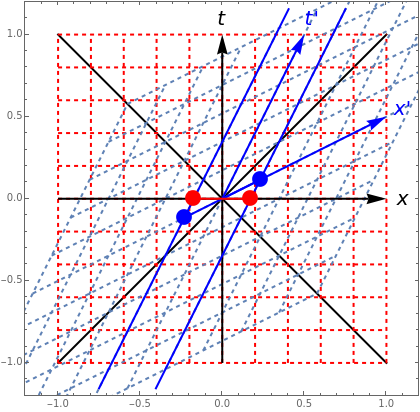Understanding Special Relativity: The Lorentz Transformation, Time Dilation, and Length Contraction
Understanding Special Relativity: The Lorentz Transformation, Time Dilation, and Length Contraction
The Lorentz transformation describes how two observers in relative motion can relate their measurements of space and time. This Demonstration illustrates the space and time axes for two observers, one at rest (black axes, red gridlines) and one in motion (blue axes and gridlines) for a single space-time event, time dilation, or length contraction. The coordinate axes can be shown for each observer, and the relative velocity can be changed at will.
You can drag the space-time event (black dot) and see its and coordinates by mousing over it.
(x,t)
(x',t')
Time dilation is the phenomenon whereby two observers disagree on the time interval between two events: moving clocks run slowly. Here the proper time of a moving observer (in blue) corresponds to a longer (dilated) time for an observer at rest (in red). You can change the proper time.
Length contraction (also known as Lorentz–FitzGerald contraction) is the phenomenon whereby two observers disagree about the length of an object: moving objects shrink. Here the proper length of a moving object (worldlines in blue) corresponds to a shorter (contracted) length for an observer at rest (in red). You can change the proper length.
Details
Details
The Lorentz transformation between two reference frames with coordinates and , in relative motion with velocity , can be represented by , or the inverse , where and . The inverse transformation is used to plot gridlines of constant and .
(x,t)
(x',t')
v
=
x' |
t' |
γ | -γv |
-γv | γ |
x |
t |
=
x |
t |
γ | γv |
γv | γ |
x' |
t' |
γ=1
1-
2
v
c=1
x'
t'
See also:
Permanent Citation
Permanent Citation
Frederick W. Strauch
"Understanding Special Relativity: The Lorentz Transformation, Time Dilation, and Length Contraction"
http://demonstrations.wolfram.com/UnderstandingSpecialRelativityTheLorentzTransformationTimeDi/
Wolfram Demonstrations Project
Published: August 15, 2011
